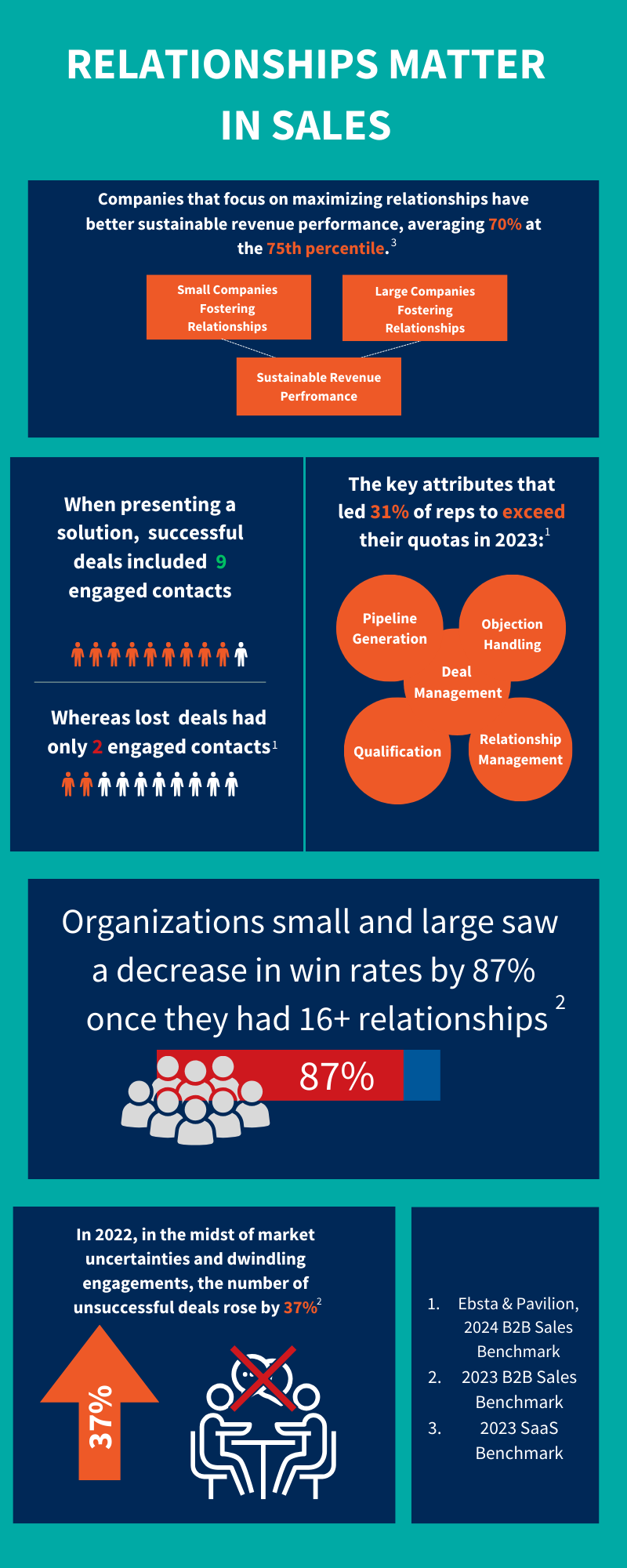Building relationships in sales offers a myriad of benefits. Not only do your teams become skilled at diagnosing and solving buyer pains, but it will also fix some issues your organization may be facing.
In fact, industry data is showing that in many issues leaders faced last year, the lack of (or too many) value-based relationships between buyers and sellers contributed to the problem. Leaders who did not focus on relationships often saw more opportunity losses. On the flip side, organizations with too many relationships also saw losses. Today, I would like to share how you can build meaningful relationships and how they will affect both you and your buyers.

Building and Fostering Relationships
In a recent study, about 75% of B2B buyers deemed their last purchase difficult or complex (Gartner). Some of these challenges come from buyers’ internal processes and the increasing number of decision makers engaged in the buying journey. Others result from uncertainty about the number of solution options—what makes them different and valuable. Help your buyers by enabling your teams to become trusted advisors and help your buyers break the status quo.
Become a trusted advisor. Your buyers crave and appreciate the trust built between themselves and your salespeople. To start building a relationship with them, here are a few tips:
- Speak plainly. The marketing speak is effective, but buyers care more about having a real conversation that they know will help them find a valuable solution. This also gives you the chance to communicate this value (both educating them on their pain and informing them about a potential approach and related outcome) to them.
- Show buyers how your solution works. This can easily be done through demonstrations. Besides, if your buyer is investing in your solution, it would help them know how it works and how it fits their needs.
- Connect your prospects to current clients. It would be best to have a network of current clients available to speak with your prospects. This allows your prospects to hear honest feedback from an actual buyer who became a client.
- Be honest. Your solution probably will not solve every problem a buyer faces or will ever face — it is important to make that clear to them. You should also communicate any limitations your solution has. This type of honesty will be a huge contributor to a long-term relationship with this buyer.
Break the status quo. Sometimes buyers do not even realize they have a problem your solution can solve, and this is often where selling organizations lose out most. Buyers typically have the same mindset when encountering an issue: This is just how it is. This is dangerous for the buyer and your deal. When buyers let the status quo win, you will often see that they do not come to a decision, leaving your deal frozen. In short, the buyer continues to struggle and you lose yet another deal. It is up to you to change this mindset. Let me share how:
- Ask questions and listen well. Not just any questions, meaningful questions that will help you — and sometimes even the buyer — uncover pains that may not have been obvious. Asking discover-based questions allows your salespeople to diagnose potential pain points and helps build or strengthen the relationship with the buyer(s). Just remember, these questions should go beyond ones that can be answered with a quick internet search and your salespeople should genuinely have the drive to serve your buyers.
- Sell after you earn their trust. Several of the ways we have discussed to build trust will also help you break the status quo. These include connecting prospects to current clients and being honest about your solution’s limitations.
- Provide proof. Have handy success stories and relevant use cases. In fact, Forrester found that 71% of buyers consider client value stories and relevant use cases the most credible sources in their buying journey.
When you form a relationship with a buyer — when you Seek to Serve™ — you become a trusted advisor they can turn to for any pains now and into the future.
The Seek to Serve™ Philosophy
Seek to Serve, Not to Sell® provides a guiding philosophy that creates a win-win situation for your buyers and your organization. Learn the ins and outs of this philosophy and how to put it into practice with the Complete Sales Organizational Guide to Seek to Serve, Not to Sell eBook.
